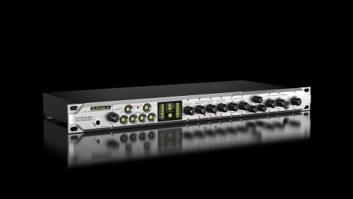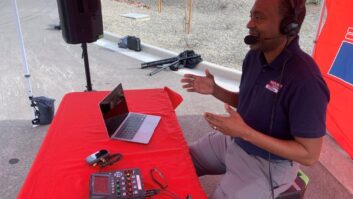(click thumbnail)Aphex Systems’ new Model 230 Master Voice Channel Processor is an analog device that combines several of the company’s proprietary voice processing effects and familiar audio tools into a single-rack-space component. It is designed to control one microphone. Initial examination of the front panel reveals an impressive collection of tools. Exploring them reveals it is capable of more than is apparent.
The 230 has a busy, matte silver faceplate dotted with soft-glowing status buttons and an attractively illuminated Aphex logo. The Reflective Plate Amplifier (RPA) tube microphone preamp is a Aphex patented circuit that claims to subtly impart sonic warmth and character while providing stable operation.
Product CapsuleTHUMBS UP:
Useful array of features in a slender package
Multiple swept controls permit custom results
Easy to use
High value
THUMBS DOWN:
No line input
PRICE: $799
CONTACT: Aphex Systems in California at (818) 767-2929 or visit www.aphex.com
My announcer read into a Sennheiser MKH-40 condenser mic, and I monitored through JBL DMS-1 ambient-field control room speakers. I found the preamp responsive and quiet – the latter being essential for broadcast microphone applications that often have no background ambience to mask the potentially hissy and hashy noise floor of tube device.
The preamp can be routed through any of the processors on board, or quite directly to the analog and digital outputs by not engaging the “in” buttons that individually insert many of the components.
The Easyrider compressor, unlike brands that have multiple user-adjustable controls, offers only drive and release knobs. Aphex states the factory-set compression algorithm automatically adapts to voice waves and reduces any pumping effect while tightening the average level flatteringly. I found this to be accurate. By driving the Easyrider hard, I was able to magnify the size of my voice almost exponentially without a trace of the usual frequency-thinning harsh edge that heavy compression usually imparts.
I find the best way to adjust the unit is to simply listen while twisting the “drive” and “release” controls until you’re happy with the results. You can then examine the amount of gain reduction and release time by changing the input meter to a GR meter with a button push.
Present and rich
The inauspicious but rather magical Phase Rotator button engages a circuit that tunes a fourth order all-pass filter to reduce the amplitude of asymmetric peaks and displace the time relationship of even harmonics to their fundamentals. While this may sound a bit techno-babble-ish, and Aphex points out it is psycho-acoustic, the result is a simultaneously present, rich and fuller product.
Any electronic fogging (high frequency “smearing”) of the voice is time-corrected by the Rotator to present a coherent signal to the ensuing electronics, especially enhancing the performance of the Easyrider compressor. This processor makes all the decisions; there are no user controls other than for the purpose of engaging it. You, the engineer, use it selectively on a voice, comparing processed with unprocessed tracks and choosing the best sounding. Trust me, this could not be accomplished by using equalization.
The single channel of parametric EQ is primarily a surgical tool with a potential of +/-12 from 240 kHz to 8 kHz. The volume knob has a unity detent, so you can bypass the equalizer if you don’t need it. The familiar “Big Bottom” circuit accomplishes low -requency contouring from 50 Hz to 280 Hz, and the Aural Exciter manages 500 Hz to 5 kHz.
Moving along to the Logic Assisted noise gate, the Threshold control knob permits wide sensitivity, and once triggered stays open through the attack-hold-release sequences. Even with steep volume reduction, the Depth knob allows control of the release and permits even extreme gating to take place transparently.
It required some contrary settings to get the gate to “chatter,” because it opens instantly and closes in a ramped, rather than clipped, fashion. Here, I discovered an unexpected capability of the 230 Master Voice Channel Processor.
When used in conjunction with accurate narrow frequency notching on the parametric EQ, the Logic Assisted gate becomes a remarkable feedback controller in SR applications. And with a judicious depth setting, this gate is quite capable of permitting an announcer to maintain a dominant presence while keeping the ambient surroundings as exciting or subdued as desired.
S-s-s
Okay, we’ve got a clean signal that’s dynamically controlled, phase corrected, background noise insulated and equalized – what more could you really need? A de-esser, that’s what.
Unlike a conventional de-esser that simply ducks the whole voice signal above some turning point, Aphex has provided a standalone limiter that uses a “split-band” technique to attenuate only the sibilance, leaving the body of the voice untouched.
This prevents noticeable compression artifacts, especially if the Easyrider compressor also is engaged. Operation of the de-esser is a one-knob affair. Just set the threshold to the point where you want the esses to be softened, and the internally set attack and release characteristics evaluate the incoming signal and limit the undesired sibilance.
Since it’s called the Model 230 Master Voice Channel Processor, of course I ran a Shure SM-57 dynamic mic through it, placed in front of a Marshall JTM45 guitar amplifier, and as I suspected was presented with a wide selection of tones and sizes. I drove the compressor quite hard and set a slow release time at about 9 o’ clock on the faceplate, used the gate to reduce amp buzz between notes, notched out some mud at around 300 Hz and compensated for the volume loss at the output gain knob.
The guitarist’s face split open in a huge grin when he heard his solo played back through the control room Genelec 1038s. I was impressed with the solid, huge power of the guitar sound and the easy time I had dialing it in. It’s not unusual to spend an afternoon getting a happening guitar tone; but this took about 15 minutes.
This device reminds me of a Bruce Springsteen concert. After a three-and-a-half-hour show, he’ll ask the audience, “Had enough?” and we holler back, “NO!” so he plays another hour. Aphex packs in a bundle of additional features such as a cough switch jack that allows easy insertion of a remotely operated mute button; low-frequency roll off; a line-level effects send and return between the dynamics processor and the equalizer section.
Add to all this AES/EBU, S/PDIF and Toslink digital outputs, +4 XLR and -10 RCA analog outputs, sample rate selectors from 44.1 kHz to 96 kHz, 24-bit resolution, internal/external word clock input and output connectors, dual-function input/GR metering and onboard phantom powering, and you’ve got a diminutive powerhouse of an audio processor. In fact, I’d name it the Aphex Master Microphone Channel Processor.












